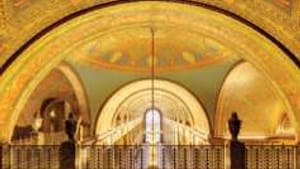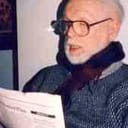Stay in the Loop
BSR publishes on a weekly schedule, with an email newsletter every Wednesday and Thursday morning. There’s no paywall, and subscribing is always free.
How self-taught architects changed the Western world
Who needs architecture school?

Middle Thuringia is in the glorious throes of honoring modern Germany's two greatest autodidact architects: the Belgian Henry Van der Velde, at Weimar's New Museum, and Peter Behrens at the Arthall in Erfurt, the state capital.
The Belgian's father was a distinguished pharmacist who balked at his son's professional interest first in art and then in music. Papa wanted him to get scientific. Henry didn't choose architecture until he was 32.
Behrens came from a prosperous Hamburg family that indulged his flair for painting. He answered the Duke of Hesse's plea that he join a new applied art school to give the dukedom a better position in newly industrializing Germany. He went to Darmstadt and built himself a splendid modern house and filled it full of furniture he designed himself.
In due course I'll review both these shows. But right now I want to explore the paradox of early modern architecture.
Couldn't afford high school
My American Lit professor at the University of Detroit, C. Carroll Hollis, turned me onto Albert Kahn, the oldest of a Jewish rabbi's six sons, who emigrated to Detroit in 1880, aged ten. Albert Kahn not only didn't go to architecture school, he couldn't even afford high school.
He started drawing for Detroit's leading architecture firm. They were so stunned by his talent that they sent him to Europe to deepen his awareness. Eventually Kahn became Henry Ford's architect. When the Depression killed commissions in Detroit, Kahn went to the Soviet Union, where he designed more than 500 buildings, many of them tank factories for the military. (When I spent a summer on his Mercury factory in Dearborn, we used to joke that Kahn won World War II singlehandedly.)
My first "favorite" Kahn building was his Beau Deco Fisher Building, with its glorious golden crown on top at night.
So I had a belated giggle when Kahn called a defense building conference in 1942 at the University of Michigan (where he had designed the major buildings.) He invited Eliel Saarinen from Cranbrook Art School, and Gropius and Mies, who were hungry for commissions. He teased them by calling them the Glass House Boys. He scorned them for building structures for looks rather than function. He sneered at the Bauhaus by contending that architecture was 90 percent business and 10 percent art.
Stunning San Francisco
I quit teaching in 1982 and went to San Francisco to live for a very satisfying decade. I soon discovered another poor German immigrant, Timothy Pflueger. His formal education ended with elementary school. No money for high school or college!
Eventually Pflueger started conceiving great ideas: Underground parking on Union Square. 540 Sutter, a doctor/dentist office building with cars parked on the lowest floors. He created a downtown depot that brought trains, boats and buses together. He created marvelous school buildings, from kindergarten to graduate school. Churches everywhere. Marvelous theaters like the Oakland Paramount.
Wood vs. concrete
Later I discovered that the great Louis Sullivan's professional education consisted of only a few courses at MIT. He hurried off to Chicago, where they needed a lot of buildings after the Great Fire of 1871. In due course, his Adler-Sullivan firm took on the similarly unschooled Frank Lloyd Wright as an apprentice. The theory was: Once you got the hang of good design by watching pros do it, you could do it, your way.
When I celebrated the 50th anniversary of Wright's Wisconsin "school" by visiting his new Arizona school, I asked the director why concrete was used in building. He replied that originally Wright used wood because the water gushing through was glorious to regard. Except that the sun made the wood evanesce. Look and learn! In their own idiosyncratic fashion, these autodidacts created modern architecture, their ways.
The Belgian's father was a distinguished pharmacist who balked at his son's professional interest first in art and then in music. Papa wanted him to get scientific. Henry didn't choose architecture until he was 32.
Behrens came from a prosperous Hamburg family that indulged his flair for painting. He answered the Duke of Hesse's plea that he join a new applied art school to give the dukedom a better position in newly industrializing Germany. He went to Darmstadt and built himself a splendid modern house and filled it full of furniture he designed himself.
In due course I'll review both these shows. But right now I want to explore the paradox of early modern architecture.
Couldn't afford high school
My American Lit professor at the University of Detroit, C. Carroll Hollis, turned me onto Albert Kahn, the oldest of a Jewish rabbi's six sons, who emigrated to Detroit in 1880, aged ten. Albert Kahn not only didn't go to architecture school, he couldn't even afford high school.
He started drawing for Detroit's leading architecture firm. They were so stunned by his talent that they sent him to Europe to deepen his awareness. Eventually Kahn became Henry Ford's architect. When the Depression killed commissions in Detroit, Kahn went to the Soviet Union, where he designed more than 500 buildings, many of them tank factories for the military. (When I spent a summer on his Mercury factory in Dearborn, we used to joke that Kahn won World War II singlehandedly.)
My first "favorite" Kahn building was his Beau Deco Fisher Building, with its glorious golden crown on top at night.
So I had a belated giggle when Kahn called a defense building conference in 1942 at the University of Michigan (where he had designed the major buildings.) He invited Eliel Saarinen from Cranbrook Art School, and Gropius and Mies, who were hungry for commissions. He teased them by calling them the Glass House Boys. He scorned them for building structures for looks rather than function. He sneered at the Bauhaus by contending that architecture was 90 percent business and 10 percent art.
Stunning San Francisco
I quit teaching in 1982 and went to San Francisco to live for a very satisfying decade. I soon discovered another poor German immigrant, Timothy Pflueger. His formal education ended with elementary school. No money for high school or college!
Eventually Pflueger started conceiving great ideas: Underground parking on Union Square. 540 Sutter, a doctor/dentist office building with cars parked on the lowest floors. He created a downtown depot that brought trains, boats and buses together. He created marvelous school buildings, from kindergarten to graduate school. Churches everywhere. Marvelous theaters like the Oakland Paramount.
Wood vs. concrete
Later I discovered that the great Louis Sullivan's professional education consisted of only a few courses at MIT. He hurried off to Chicago, where they needed a lot of buildings after the Great Fire of 1871. In due course, his Adler-Sullivan firm took on the similarly unschooled Frank Lloyd Wright as an apprentice. The theory was: Once you got the hang of good design by watching pros do it, you could do it, your way.
When I celebrated the 50th anniversary of Wright's Wisconsin "school" by visiting his new Arizona school, I asked the director why concrete was used in building. He replied that originally Wright used wood because the water gushing through was glorious to regard. Except that the sun made the wood evanesce. Look and learn! In their own idiosyncratic fashion, these autodidacts created modern architecture, their ways.
What, When, Where
Albert Kahn: Inspiration for the Modern. Brian Carter, ed. University of Michigan Museum of Art, 2001. 76 pages; $209. www.amazon.com. Time and Tim Remembered. Milton T. Pflueger, ed. Pflueger Architects, 1985. 150 pages’ $49.49. www.amazon.com.
Sign up for our newsletter
All of the week's new articles, all in one place. Sign up for the free weekly BSR newsletters, and don't miss a conversation.
 Patrick D. Hazard
Patrick D. Hazard